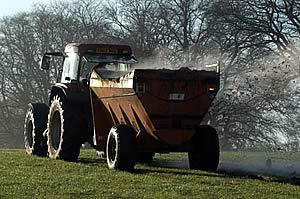14/11/08
With fertiliser prices more than doubling over the last 12 months, the value of the nutrients in manures and slurries is now over twice as much as it used to be. According to NRM Laboratories that means that making sure organic nutrients are managed well has never been more important to the bottom line.
“It is only by understanding the nutrient status of the soil and the level of available organic nutrients that sensible, informed decisions can be made about how much bagged fertiliser to apply,” says Sean Stevenson, Business Development Manager at NRM Laboratories, the UK’s largest agricultural testing facility. “Kneejerk reactions to cut back are understandable but, unless they are based on good information, the result could easily be yield and quality penalties,” he adds.
However the NPK content of manures and slurries can be very variable which is why analysis clearly has a significant part to play in integrating organic and bagged fertilisers.
For example, NRM results show that manures can contain as little as 0.11kg/t phosphate (P2O5) or as much as 45kg/t. These amounts are worth, at face value, between 17p/t and £68/t. Whilst clearly not all of the nutrient will be available to the crop, RB209 suggests around 60% is a sensible proportion which still represents a potential saving of up to £40/t.
Looking at potassium in slurry as another example; this can contain anything from 0.01kg/m3 K2O up to 8.3kg/m3. With 90% of that potash being available to the crop the sums work out at anything from around 1p/m3 up to almost £9/m3. There are equally wide ranges for nitrogen in both manures and slurries, although working out availabilities is a more complicated exercise.
Importance of PK status
It is well documented that when PK indices are at less than optimum levels both yield and quality will suffer and that applies to arable crops, forage crops and grassland. NRM Laboratory Manager Tony Morgan explains, “As we have seen, manures and slurries can contain useful amounts of P & K making them valuable in replacing PK offtakes and in building PK indices.”
Because NRM analyses over 270,000 soil samples every year the company has a unique overview of the PK status of UK soils.
Mr Morgan continues, “In arable and forage crops almost a quarter (23%) of soils have a P Index below the target value of 2. The K Indices are even worse with almost 2 in every 5 (37%) below the target of 2 minus. Surprisingly 30% of grassland soils also have low P Indices i.e. below Index 2 with 43% of soils being below the target value of K Index 2 minus.
This is not to say that there is no scope for fertiliser savings. “Our statistics show that a third (32%) of soils sampled had a K Index above the target value and that over 40% had a P index above the target. The trick is to identify which fields can be given a PK holiday and which cannot and the only reliable way is to test the soil.”
 Spring Oilseed Rape Tops the Charts Spring Oilseed Rape Tops the Charts
 Bacteria Manage Perfume Oil Production from Vetiver Grass Bacteria Manage Perfume Oil Production from Vetiver Grass
 Success of Barenbrug Perennial Ryegrass Breeding Programme Success of Barenbrug Perennial Ryegrass Breeding Programme
|



